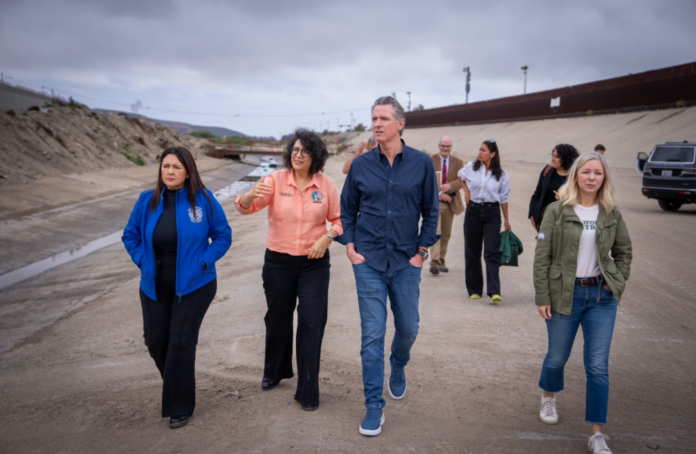
VOICE & VIEWPOINT NEWSWIRE
Gov. Gavin Newsom visited San Diego wastewater treatment facilities earlier this week to assess rehabilitation efforts and the ongoing sewage crisis, a long-standing environmental and public health issue.
The Tijuana River has fueled a decades-long pollution crisis along the U.S.-Mexico border, impacting public health, closing beaches, and severely degrading the Tijuana River Estuary and coastal waters from Tijuana to Coronado.
Since October 2023, a staggering 31 billion gallons of raw sewage, polluted stormwater and trash have flowed down the Tijuana River Valley and into the Pacific Ocean, according to local environmental organization San Diego Coastkeeper.
In his first visit to the treatment plants, Gov. Gavin Newsom joined San Diego County Board of Supervisors Chairwoman Nora Vargas on Monday Oct. 28 for a briefing and a status update on the South Bay International Wastewater Treatment Plant (SBIWTP).
The primary function of The South Bay International Wastewater Treatment Plant, built in the early 1990’s, was to treat wastewater pumped frenim Tijuana before it was discharged into the Pacific Ocean. However, the plant’s capacity has been significantly outpaced by Tijuana’s explosive growth and the increasing volume of wastewater generated.
Thanks to partnerships with California’s congressional delegation and the Biden-Harris administration, Gov. Newsom helped secure $453 million in the last two years to go towards “critical upgrades” to the South Bay International Wastewater Treatment Plant.
“With upgrades to facilities on both sides of the border, sewage flows are expected to be reduced by up to 90%,” Gov. Newsom said.
The fallback on this for South Bay residents has led to polluted air and contaminated beach waters, generating a trend in gastrointestinal symptoms such as vomiting and diarrhea as well as symptoms associated with asthma among residents.
“Pollution in the Tijuana River Valley is the number one environmental health crisis impacting our region, and Governor Newsom coming to San Diego for today’s briefing shows his steadfast commitment to our communities,” said Chairwoman Vargas.
Other recent efforts to address the crisis is District 3 Supervisor Terra Lawson-Remer’s submission last week for the Environmental Protection Agency to investigate the Tijuana River Valley for harmful toxins in the soil, sediment, and groundwater. This would be necessary to qualify the Tijuana River Valley as a “superfund site” which would unlock federal funding to clean up hazardous waste.
“The EPA must act now to designate the Tijuana River Valley as a Superfund site. Our South Bay communities have a right to breathe clean air, drink safe water, and live without fear of contamination. We owe it to every family, every child, and every resident who’s been forced to live with this toxic pollution for far too long.” said Imperial Beach Mayor Paloma Aguirre.
Meanwhile the county has allocated $2.7 million to go towards the distribution of free air purifiers for thousands of impacted families in the South Bay, and has also secured a partnership with the CDC to perform a health assessment survey with impacted residents .
“I have said time and again that the only way we will solve this crisis is by working together. Our collaboration with Governor Newsom, as well as our federal partners, is critically important. We’re working to put forward our best collective efforts to restore and protect our region,” said Chairwoman Vargas.

